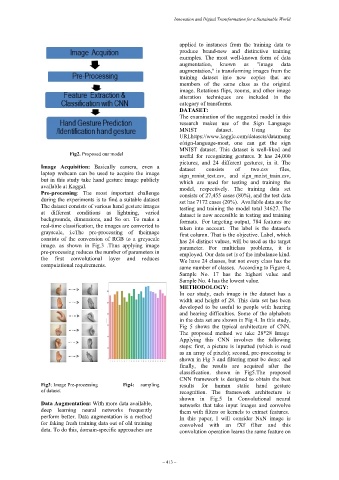Page 457 - Kaleidoscope Academic Conference Proceedings 2024
P. 457
Innovation and Digital Transformation for a Sustainable World
applied to instances from the training data to
produce brand-new and distinctive training
examples. The most well-known form of data
augmentation, known as "image data
augmentation," is transforming images from the
training dataset into new copies that are
members of the same class as the original
image. Rotations flips, zooms, and other image
alteration techniques are included in the
category of transforms.
DATASET:
The examination of the suggested model in this
research makes use of the Sign Language
MNIST dataset. Using the
URLhttps://www.kaggle.com/datasets/datamung
e/sign-language-most, one can get the sign
MNIST dataset. This dataset is well-liked and
Fig2. Proposed our model useful for recognizing gestures. It has 24,000
pictures, and 24 different gestures, in it. The
Image Acquisition: Basically camera, even a dataset consists of two.csv files,
laptop webcam can be used to acquire the image sign_mnist_test.csv, and sign_mnist_train.csv,
but in this study take hand gesture image publicly which are used for testing and training the
available at Kaggal. model, respectively. The training data set
Pre-processing: The most important challenge consists of 27,455 cases (80%), and the test data
during the experiments is to find a suitable dataset set has 7172 cases (20%). Available data are for
The dataset consists of various hand gesture images testing and training the model total 34627. The
at different conditions as lightning, varied dataset is now accessible in testing and training
backgrounds, dimensions, and So on. To make a formats. For targeting output, 784 features are
real-time classification, the images are converted to taken into account. The label is the dataset's
grayscale, i.eThe pre-processing of theimage first column. That is the objective. Label, which
consists of the conversion of RGB to a greyscale has 24 distinct values, will be used as the target
image. as shown in Fig.3 .Thus applying image parameter. For multiclass problems, it is
pre-processing reduces the number of parameters in employed. Our data set is of the imbalance kind.
the first convolutional layer and reduces We have 24 classes, but not every class has the
computational requirements. same number of classes. According to Figure 4,
Sample No. 17 has the highest value and
Sample No. 4 has the lowest value.
METHODOLOGY:
In our study, each image in the dataset has a
width and height of 28. This data set has been
developed to be useful to people with hearing
and hearing difficulties. Some of the alphabets
in the data set are shown in Fig 4. In this study,
Fig 5 shows the typical architecture of CNN.
The proposed method we take 28*28 Image
Applying this CNN involves the following
steps: first, a picture is inputted (which is read
as an array of pixels); second, pre-processing is
shown in Fig 3 and filtering must be done; and
finally, the results are acquired after the
classification. shown in Fig5.The proposed
CNN framework is designed to obtain the best
Fig3: Image Pre-processing Fig4: sampling results for human static hand gesture
of dataset recognition. The framework architecture is
shown in Fig.5 In Convolutional neural
Data Augmentation: With more data available, networks that take input images and convolve
deep learning neural networks frequently them with filters or kernels to extract features.
perform better. Data augmentation is a method In this paper, I will consider NxN image is
for faking fresh training data out of old training convolved with an fXf filter and this
data. To do this, domain-specific approaches are convolution operation learns the same feature on
– 413 –

